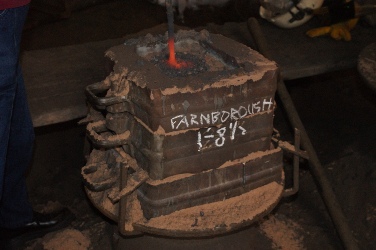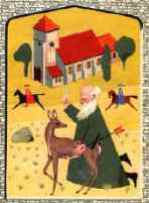

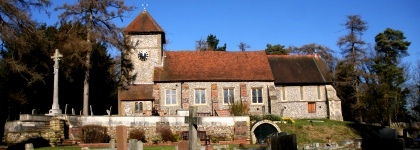
ST GILES BELLS - FOUNDRY VISIT
Thursday 16th February 2012 saw a group of about 30 people from the Orpington area travel to the Taylor’s Bell Foundry in Loughborough to witness the casting of a new bell to complete the new peal of bells shortly to be installed in the tower at St Giles, Farnborough.
Some of these people, including an encouraging number of youngsters, are learning to ring on the bells at St Martin’s Chelsfield while others that descended on Loughborough are members of the St Giles congregation. In addition, some Chelsfield ringers and friends also attended. The casting date had been deliberately agreed with the foundry to coincide with half term week so that school-aged children, who make up a good percentage of the learners, could attend.
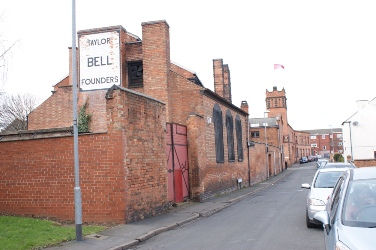 |
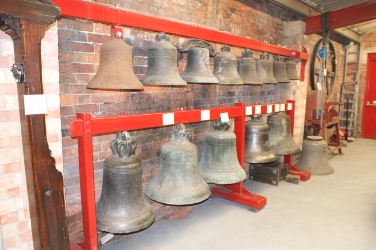 |
| The foundry buildings | Inside the musem |
The bell foundry is a working factory and so there were strict rules to adhere to such as no open-toed shoes and a list of attendees had to be given in to Mary Barrass of Taylor’s on arrival. Mary is an experienced ringer and has rung on almost all the peals of bells worldwide – close to 6,000 – so we were in good hands!
It was lunch time when we all checked in at the foundry entrance which houses the foundry shop and forms the meeting point for the start of the museum tour. We were fortunate and delighted to learn that our guide for the afternoon was Revd. David Cawley, who has a long association with Taylor’s and is currently responsible for a parish in Margate. David has visited the tower at St Giles and been very helpful with advice and encouragement in getting the St Giles bell project running. He has extensive experience with bell installation works, particularly with light bells and has been a Diocesan Advisor and is an Honorary Life Member of the Kent County Association of Change Ringers. In fact, David is so keen on all things associated with bells that he undertook to act as our guide during a period of leave from his Kent parish!
While the furnace was heating up the bell metal for our bell, we had the benefit of David’s knowledge and he showed us a range of bells in the Taylor’s museum from different eras and we could see how, over the centuries, the bells have changed in shape and sound
While the furnace was heating up the bell metal for our bell, we had the benefit of David’s knowledge and he showed us a range of bells in the Taylor’s museum from different eras and we could see how, over the centuries, the bells have changed in shape and sound.
More modern bells are tuned in a highly sophisticated way compared to their predecessors that were frequently cast in a field adjoining the church and then roughly tuned by having chunks chipped off them with a hammer and chisel!
After spending some time in the museum we then went on a tour of the foundry where we saw various bells some of which were awaiting installation or looking for a new home after being removed from a tower as part of a bell project. One such example was the old tenor bell from St Michael’s, Cornhill which became redundant when a new peal of 12 bells was installed in 2011. The old tenor - the heaviest bell - weighed in at a massive 2 tons and 2 hundredweights!
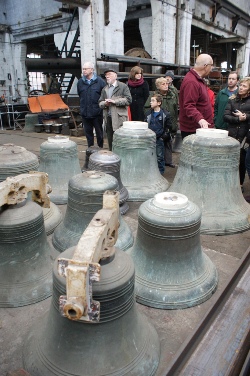 |
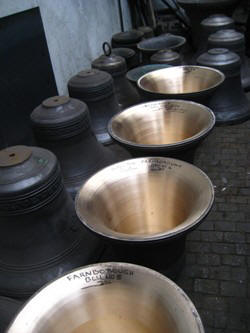 |
|
It was explained to us that to cast a bell there is an inner and outer mould and molten bell metal is poured in the gap and that any inscriptions have to be produced back to front so that they read correctly on the finished bell. The inscription has to be type set very carefully as misprints aren’t easy to rectify! We were shown an example of an historic error ‘LOVE DOG’ ! We hope the inscription for our bell was double checked so no such error arises!
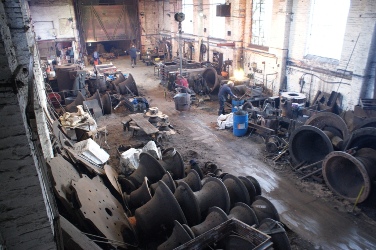 |
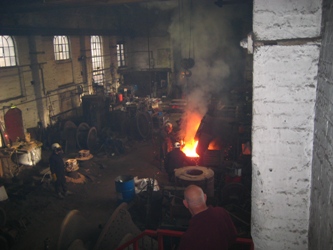 |
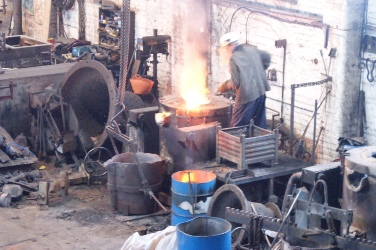 |
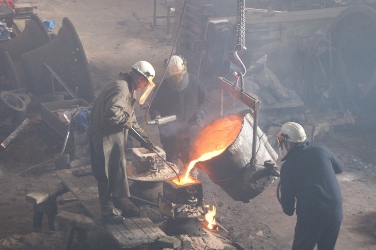 |
Once all the hot work was finished we were allowed down on to the foundry floor to see the mould at close quarters. It will need several days to cool down (see below) before the mould can be removed and the bell can then be tuned the following week. After this we returned to the foundry shop and made a few purchases before going on our way.
Once ringers had adjusted to the lighter bells they acquitted themselves very well and the younger and smaller ringers were particularly able to shine as the bells were not physically demanding.
After that we all went on our separate ways tired but very happy with the day’s events and eagerly awaiting the installation of our new ring of bells.
Nick Wilkins Feb. 2012
